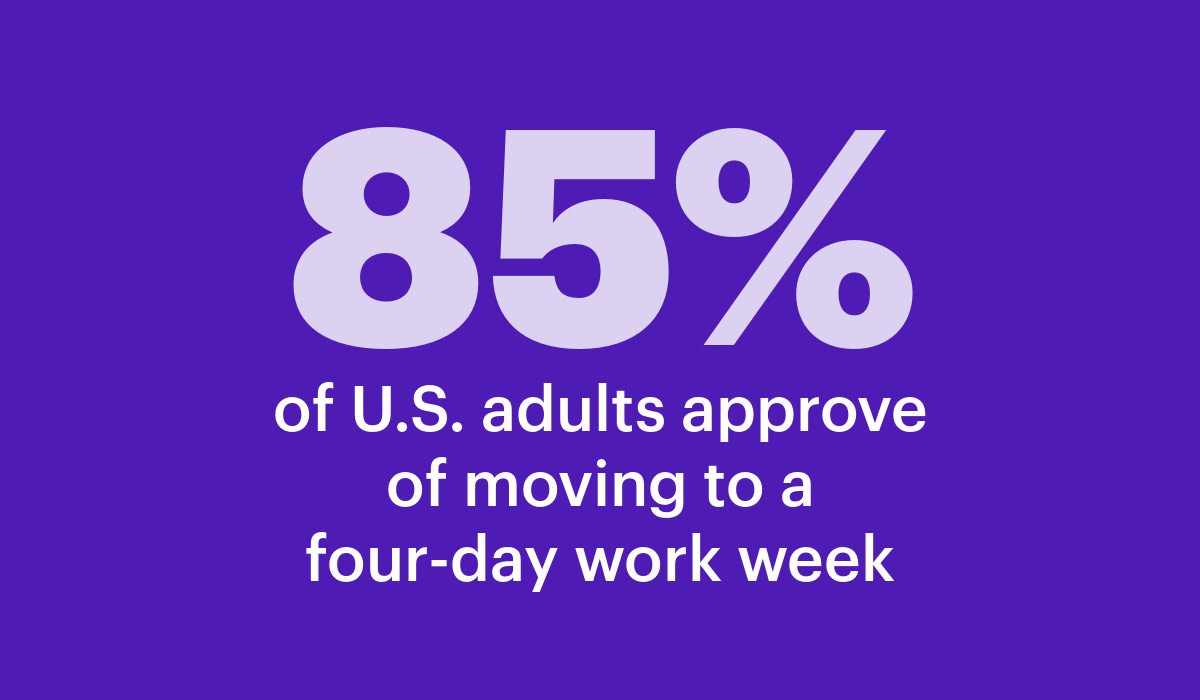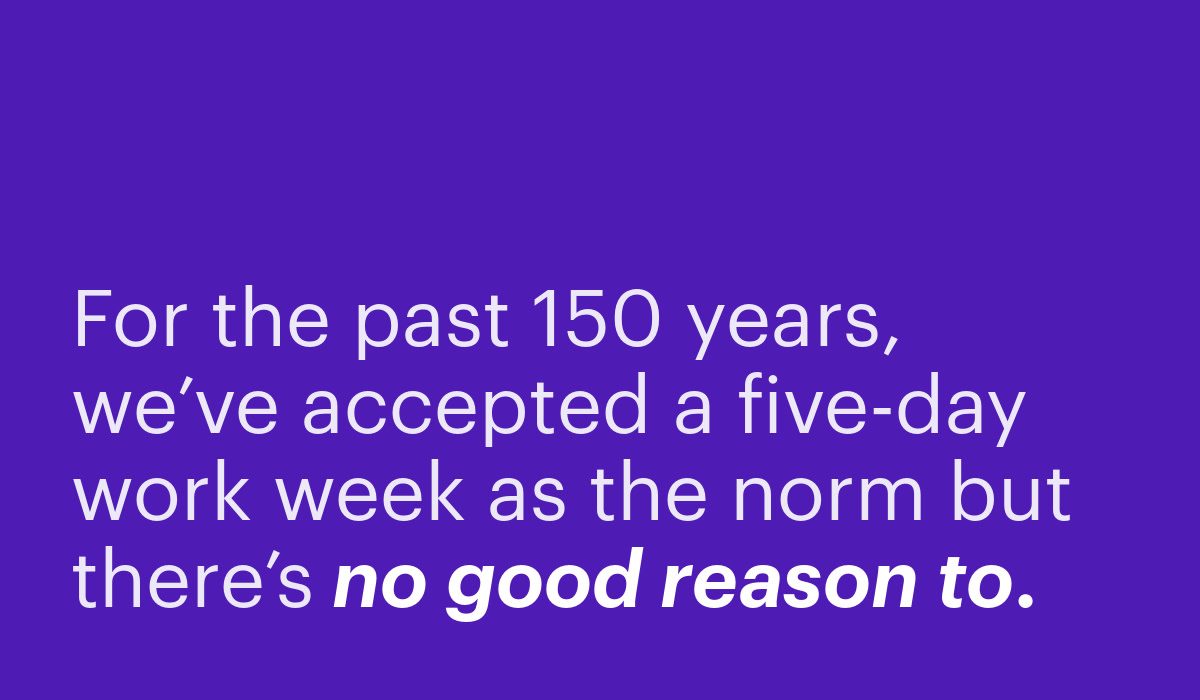Radical or Practical? The 4 Day Work Week and the Future of Work
Is a 4 day work week a good idea? Read this article to find out which countries are already doing it and learn pros and cons.

After getting a taste of a more flexible work life during lockdown, workers and employers now embrace the idea of a four day work week. Once considered a utopian dream, the four day work week has become a practical reality for some. When asked, 85% of US adults already approve of moving to a four day work week, according to the 4 Day Week Campaign.

Is a 4 day work week a good idea?
We may be ready for a 4-day work week. COVID-19 showed us that it is possible to think differently about how, where, and when we work. The idea isn’t new and, despite much criticism, isn’t a way to reward workers for being lazy. Workers would work just four days a week but with the same workload and with the same pay and benefits. Advocates say this leads to fewer meetings (which are often unproductive) and more deep work for individuals. Workers may also be more motivated.
Jack Kellam, a researcher with Autonomy UK, a London-based think tank founded in 2017 that focuses on the future of work, says there has been a big surge of interest in the last year or so as companies look for ways to re-engage workers. “One thing the pandemic showed us is that it is possible for working practices to change overnight.” With a newfound openness to how work is structured on the part of both employees and employers alike, he says that he sees more experimentation.
What are the advantages of a 4 day work week?
A longer weekend gives people more time to decompress
Fewer meetings means workers can focus on doing the work that needs to get done
More deep work results in increased innovation
What are the disadvantages of a 4 day work week?
It may make it harder to schedule necessary meetings
Some employees may take unfair advantage
HR departments don’t have a good way to track people’s time
Who is driving the move to a four day work week?
The decision to move to a four day work week can come at the government level, the company level, or it can be driven by unions (who see it as a more equitable arrangement). “Lots of employers are seeing it as a policy that can work for both retention and acquisition,” says Kellam. Offering your employees a four day work week is a good alternative to enticing them with higher wages at a time when buying power has remained somewhat stagnant due to inflation.
Iceland’s experiment with a 4 day work week
Autonomy UK and the research organization Association for Sustainability and Democracy (Alda) in Iceland’s analysis have contributed greatly to the world’s understanding of the benefits of a shorter work week. From 2015-2019, Iceland ran two large-scale trials of a reduced working week of 35-36 hours with no reduction in pay for 2,500 workers—over 1% of Iceland’s entire working population. Results have been so positive that 86% of the country’s workforce are now working shorter hours or gaining the right to shorten their hours. Unions are following the government’s lead by renegotiating contracts.
The main takeaway? Productivity remained the same or improved marginally but worker well-being was dramatically better, including perceived stress and burnout, and it led to improved health and work-life balance. Other governments are following suit.
UK’s 4 day work week experiment
In part as a response to this report, the UK kicked off a six-month pilot program in June to determine the effects of a four day work week on productivity, worker well-being, and even the impact on the environment and gender equality. While the report itself has been praised by politicians, economists, and academics, it will take time for the data to come in.
European Union’s 4 day work week
The EU is leading the way in implementing a four day work week, with support from unions and governments. In February 2022, Belgium introduced the option of a four day work week for anyone who wanted it. The idea has been enthusiastically adopted by Gen Z workers, who studies show, are more open to alternative work arrangements than were prior generations. Here too, the pandemic plays a role, as many young people were forced into lockdowns and online classes that upended their schedules. Not only are they quite used to working anywhere at any time, but they are also more conversant with the latest digital tools and therefore able to get much more and better quality work done in a shorter amount of time.
What once seemed radical is actually a practical, even conservative idea that’s been a long time coming. Looking at the historical trend over the last 150 years, you’ll see that this extra leisure naturally progresses from increased productivity. Even without this effort, we’d hit an average four day work week somewhere in the early 2030s.
Benefits of a four day work week
The Autonomy report The Shorter Working Week: A Radical And Pragmatic Proposal shows that there is “no positive correlation between productivity and the number of hours worked per day,” therefore it does not make sense to work people to the bone. Further, it also found that reducing the working week can help reduce air pollution and our overall carbon footprint and lead to better mental and physical health for employees.
Iceland’s trial contributes to a growing bank of evidence that suggests giving workers more agency over how they divide up their time can lead to happier and thus more productive workers. A misconception about the four day work week is that it requires people to work one less day a week, perhaps taking off Friday to make a three day weekend. In fact, it is about redistributing those eight hours differently. A couple with small children, who both work at home, for example, could schedule their hours to better manage domestic chores and childcare. “What’s interesting about having more time to yourself is that you can choose how you want to spend it,” says Kellam.
Doing more work in less time
That there is nothing sacrosanct about the idea of working five days a week. In the industrial age, people typically worked a six-day work week, taking off one day a week for religious reasons. For the past 150 years, we’ve accepted a five day work week as the norm but there’s no good reason to.

As factories geared up and more automation has emerged, it has become possible (and indeed) commonplace for humans to do more in less time. More recently, advances in computer science and artificial intelligence are accelerating this trend. But, according to Kellam, the transition to a five day work week didn’t come about entirely due to increased productivity. Instead, it was the unions advocating on behalf of workers when it became clear that all of this automation wasn’t making life any better for workers.
The false economy of a longer work week
Capitalism promotes the idea that it is noble to work longer hours but in fact, this is a false economy. Instead of more productivity, what you typically get is burned-out workers who resent their employers. The research shows that workers with more flexible schedules are less stressed, more engaged, and all around happier in their jobs than those that are forced to stick to a schedule. In startups, where the culture expects you to work long hours and be available outside of working hours for work, the exact opposite is true. This is one reason why startups typically have higher rates of attrition than other kinds of businesses.
More recently, productivity experts have introduced concepts such as inbox zero, getting things done (GTD), and bullet journaling. They’ve advocated for less email and fewer meetings (when meetings are required, they should be structured and include a clear agenda and accountability). But workers can easily get bogged down in the process. As with an earlier age of automation, none of these things are really making workers more productive.
Productivity gains of a 4 day work week vary
Another thing that Autonomy UK discovered is that the productivity gains of a four day work week can vary from industry to industry. It is particularly helpful in creative and administrative industries where people often work alone for hours at a time. Instead of endless meetings, they propose deep work where employees block out significant portions of their day to work alone completing projects. This doesn’t work as well in industries where face to face interaction is the norm, such as a retail environment or hospitality, but can still be helpful in job sharing scenarios.
Kellam’s advice for organizations that are considering this? Make sure you plan accordingly and include your workers in the planning process. He encourages management to step back and let workers steer the conversation. “A lot of good things can come out of these discussions that can make the workplace better and more productive.” In addition, he says it is important to decide how you are going to measure success.
Shorter work week hugely popular
While participation is voluntary, it’s interesting to note that 70 UK companies and 3,000 employees have signed up for a program run by researchers at Cambridge and Oxford Universities, Boston College, and the non-profit advocacy groups 4 Day Week Global, the 4 Day Week UK Campaign, along with Autonomy. Ireland, Scotland, Wales, Canada, Australia and New Zealand, and the U.S. are expected to start similar trials shortly. In California, Congressman Mark Takano has just introduced legislation to make the four day work week in California a reality. In the UK, not-for-profit organizations champion the introduction of a shorter work week because they lack the finance to offer competitive salaries so they see this as a perk instead.
Kellam says that the initial push in the U.S. is coming from forward-thinking private companies, many of them located in Silicon Valley, such as Apple, Facebook, and Google. As in an earlier era, it is the partnership of progressive businesses, a strong labor movement, and government that is turning what was once considered a dream and turning it into a practical reality.
Interested in learning more about Visier? Get in touch with us for a demo!


